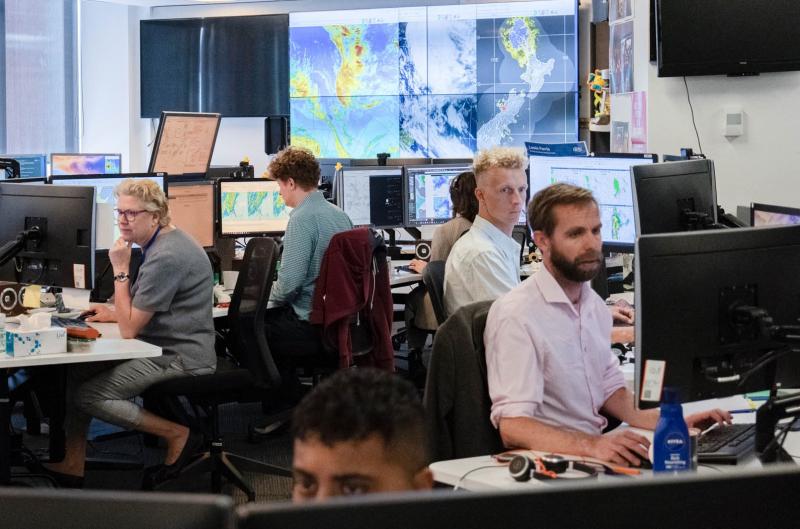Some may think it’s one of those jobs which anyone might turn their hand to, but the difficulties of weather forecasting are hugely underrated.
After all, there aren’t many jobs where you’re expected to predict the future. Economists are also required to make forecasts, but at least they have some control over the system they are foretelling. When it comes to weather, meteorologists have no such influence.
The best weather forecasting is a mixture of science, geography, and experience.
The science of meteorology is extremely complex, involving difficult atmospheric physics and chemistry, and convoluted mathematical equations. As well as having a higher degree in physics or maths, a meteorologist must know a great deal about the geography of Aotearoa New Zealand and how the prevailing westerly winds at our latitude push over and around mountains and through narrow sea straits, influencing our weather.
There is no substitute for experience in forecasting and for having seen how a certain weather pattern has affected the country in the past. This base of knowledge and skills builds insight that comes naturally after years in the job and cannot easily be taught.

(Above: Metservice meteorologists working at the National Forecasting Centre)
Simplifying the complicated
MetService forecasters work every hour of every day of the year to interpret the complexities of the atmosphere above Aotearoa New Zealand and communicate this clearly and simply to different audiences.
Our highly trained staff work tirelessly to ensure New Zealanders are kept safe and that communities can be as resilient as possible in the face of severe weather. People need to be able to trust the weather information they receive to enable them to make the best decisions they can.
One of the biggest tasks for meteorologists these days is analysing which of the suite of computer models they receive from around the world is producing the most likely weather map on which to base their forecasts.
Technology may be crucial to our operation but the forecasts themselves are still the result of a great deal of human effort and acumen. Our meteorologists interpret the models and all the observations made around the country, and apply their knowledge of a region’s topography, aspect and broader physical characteristics before settling on a forecast.
Knowing when to trust the models
There are curve-ball occasions when the models appear to go rogue, predicting tropical cyclones or icy southerlies with snow right across the motu / land. This is when meteorologists have to be at the top of their game – knowledgeable and confident enough to ignore such over-the-top predictions. After all, the models are just a guide from which forecasts are made.
The MetService forecasting team meets for about half an hour every morning online, just before 10am, to discuss the weather situation and which of the global models seem to be going down the right track. Another briefing is held about 10.30pm for the night-shift forecasters.
The weather briefings were known as “nodding”, a tradition which started more than 60 years ago. In those days, the chief forecaster’s views were unchallengeable, and everyone else would just “nod” in agreement.
These days, the meetings in the National Forecasting Centre in Wellington are called “map discussion” and are much more democratic. One of the senior meteorologists will choose which model is telling the most likely story or, if there is no clear guidance, will consider which mix of models appear to work. This is where observations, backed up by radar and satellite imagery, are vital.
Discussions follow and, from those, teams of meteorologists then write forecasts for different customers.
Tailoring our forecasts
The aviation team provides forecasts for airlines, general pilots and airports around New Zealand, and also acts as the Volcanic Ash Advisory Centre, should a volcano erupt.
Marine forecasters warn of high winds and bad weather in our inshore areas and across a huge area of oceans around the country.
Specialised severe weather meteorologists focus on heavy rain and snow, high winds, and thunderstorms which could cause damage and threaten life and livelihoods. During the tropical cyclone season (November to March), they also monitor the development of such storms. These forecasters work closely with emergency management and local and regional council staff when the worst weather is on the way.
Meteorologists working on the public and weather communications sections make the day-to-day predictions and generate the forecasts and weather graphics most of us see on the MetService website, or on the app on our phone, or on the television and elsewhere in the media.
To be a MetService meteorologist, you need a degree in either maths or physics and then to have completed a post-graduate meteorology programme which aligns with the World Meteorological Organisation’s Basic Instruction Package for Meteorologists. This ensures all meteorologists around the globe are adequately skilled.
In Aotearoa New Zealand, the meteorology programme is run in conjunction with Te Herenga Waka Victoria University as a Master of Meteorology degree.
Next time there’s rain threatening, a storm is on the way, the wind is picking up, or it’s just a lovely sunny day, you can have confidence that highly trained MetService meteorologists are providing the best possible forecasts to keep you safe and in the picture.